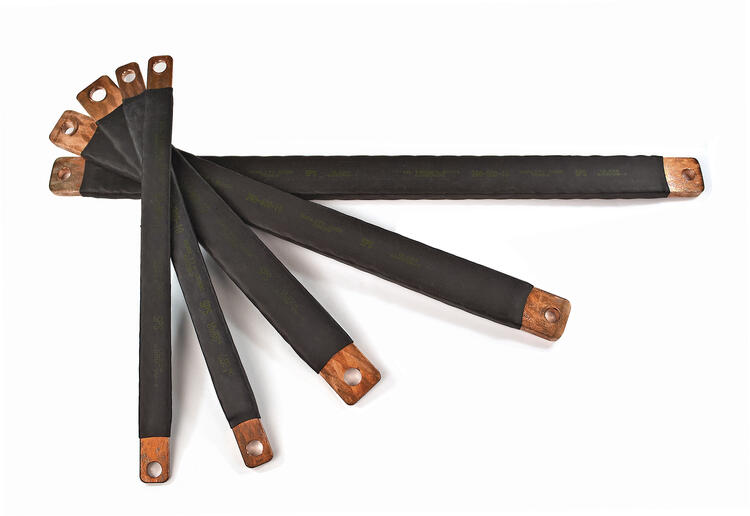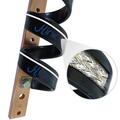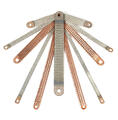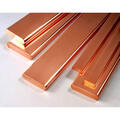Busbar
Electrical parameters: rated intensity value to carry based on the conductor cross-section and number, and the resulting voltage loss.
Mechanical parameters: bar size and number, based on the panel board dimensions and on their mechanical resistance.
Other factors to consider which might limit the passage of current through the selected conductors are linked to the working temperature of the conductor and to its capability to dissipate heat. In electricity, there is also a phenomenon called "skin effect" which determines the concentration of current on the conductor’s surface. The best conductor is therefore a flat one such as drawn bars in which the bar length and thickness ratio is the highest possible.
E.g. for the same cross-section and working temperature, a 100 x 5 mm bar carries 1.431 A, whereas the same cross-section, with 50 x 10 mm bar carries 1.129 A.


Laminated Busbar
Coflex
- Standard length: 2 - 3 m
- Working temperature: -40°C…+105°C
- Rated voltage: 1000 V AC / 1500V DC
- Coloured Identification line


Flexible COPPER BRAIDS
J-LINK, J-LINK PLUS
- Cross-section: 25 mm² to 240 mm²
- Lengths from 230 mm to 1030 mm
- 125 A to 630A
- Thickness: 2 mm


MBS Earth braids
- Available tinned or copper bare
- Press welded ends, no additional ferrules required
- Custom lengths and hole sizes available on request
- Quick and easy to install, no preparation required


Busbar Accessories
- High current and flat clamps
- Din rail fixings
- Twisting/bending tool
- Pressure plates
- Drilling jig


SOLID COPPER BUSBARS
PRP
- Thickness of 5 mm and 10 mm
- Length 1750 and 4200 mm
- Electrolytic Copper Cu-ETP 99.90%,


THREADED COPPER BARS
BRF
- Thickness 2 - 3 - 4 - 5 - 10 mm
- Length 1000 and 2000 mm.
- M5 - M8 available


PREPUNCHED COPPER BARS
BRP
- Length : 1750 mm
- Thickness : 5 mm and 10 mm
- Drilled with 10,5 mm diameter at 25 mm distance


SOLID ALUMINIUM BARS
BAP
- Thickness 10 mm.
- Length 2000 and 4000 mm
- Significant cost saving
- Weight saving up to 70%


ISOFLEXX laminated busbar
Isoflexx®
- Material: CU 99.99999 pure
- Laminate thickness: 0.5mm to 1mm
- CSA: 22mm² to 1200mm²
- Rated current: 130A to 3725A
- Operating temperature: -50°C to 180°C


ULTRAFLEXX ultra flexible busbar
Ultraflexx®
- CSA: 25mm² to 240mm²
- Rated current: up to 1200A with two parallel conductors
- Insulation: UL94 VO chlorine and fluorine free
- Volatge Rating - 1000VAC/1500VDC according to IEC 61439-1. 600VAC/750VDC According to UL
- Dielectric strength: 20kV/mm

More information about Busbar
ADVANTAGES
Pre-punched and threaded copper barsFind out more here.
Related

We now offer cable
What tri-rated cable are you currently using? Does the product or service you receive leave you wanting more? It’s time to ask the question. Because now, you’ve got options.

Terminal Blocks For Push In Connection Systems
This innovative push-in connection system enables time savings of up to 50%, whether you're wiring control panels or managing complex installations

Electrical Protection in the Solar Era: How to Choose Fuses for Modern Photovoltaic Installations
Solar energy has become a pillar of the global energy transition. The experts at OEM Automatic have broken down the role of photovoltaic fuses and their contribution to solar systems, as well as, how to choose the right solution for you.

Fuse links for semiconductor protection
Ultra fast-acting fuse links engineered specifically to shield delicate semiconductor devices.

Lightning and surge protection for DC and control signals
Do you need reliable protection for measuring and control equipment? DEHN YellowLine delivers voltage surge protection tailored for building, measuring, and control systems

MCBs vs ECBs: Which is best for securing DC circuits?
Choosing the right circuit breaker is important for protecting DC circuits. Two primary forms of protection are MCBs and ECBs. The experts at OEM Automatic breakdown the two circuit breakers for you!